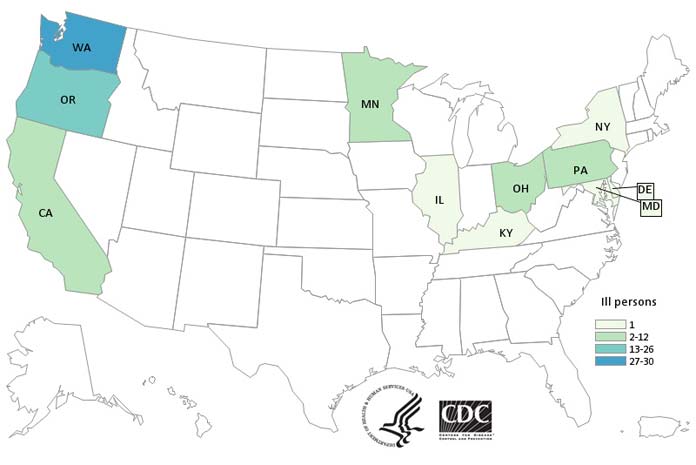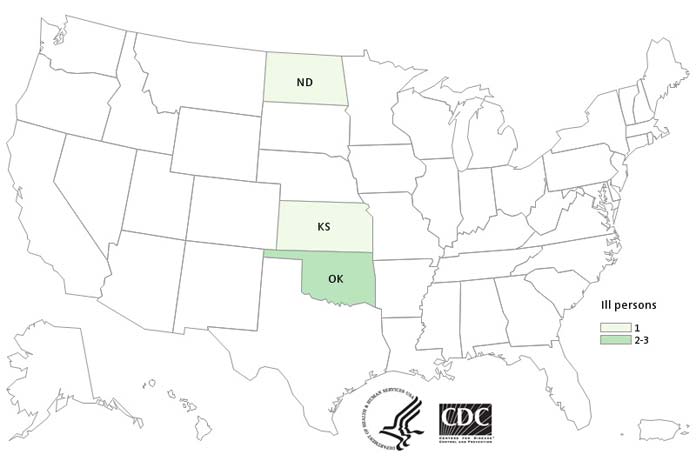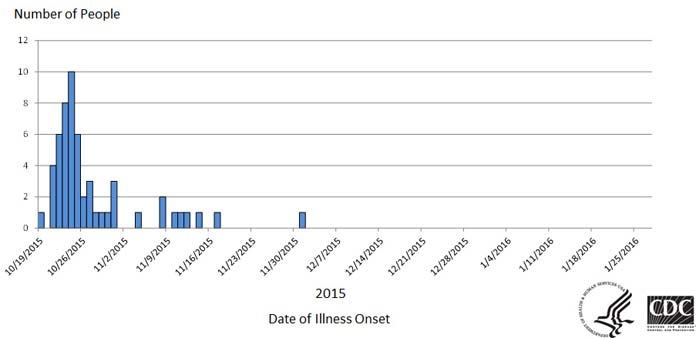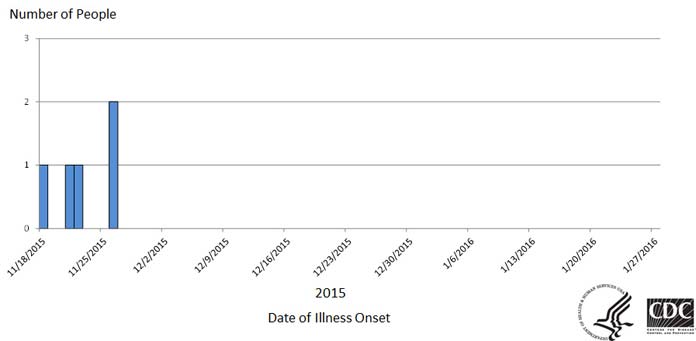Our law firm has filed a lawsuit against Chipotle for E. coli O26 poisoning in an outbreak linked to restaurants in several states. Although this outbreak is over, you should contact our food poisoning legal team to find out if you have the right to sue for compensation and, if so, what you need to do to protect your rights.
Two E. coli O26 Outbreaks Associated with Eating at Chipotle Restaurants
In 2015, there were two outbreaks of E. coli O26 associated with eating at Chipotle restaurant. The specific menu item that caused the illnesses was never pinpointed, which does not preclude a lawsuit against the company.
- In the initial, larger outbreak, 55 people infected with the outbreak strain of E. coli O26 were reported from 11 states: California (3), Delaware (1), Illinois (1), Kentucky (1), Maryland (1), Minnesota (2), New York (1), Ohio (3), Oregon (13), Pennsylvania (2), Washington (27). Twenty-one ill people were hospitalized.

- In the second, smaller outbreak, 5 people infected with a different strain of E. coli O26 were reported from 3 states: Kansas (1), North Dakota (1), and Oklahoma (3). One ill person was hospitalized.
E. coli Outbreak and Chipotle Lawsuit Timeline
October 19, 2015
Onset of illness for the first outbreak of E. coli linked to Chipotle (Outbreak 1) ranged from October 19, 2015 to December 1, 2015, according to the CDC.
October 31, 2015
The Washington State Department of Health and the Oregon Health Authority made Outbreak 1 public with press releases.
“A cluster of E. coli cases led to the voluntary closure of many Chipotle restaurants this week. The restaurants under investigation are linked to 19 cases of E. coli illnesses in Washington. Three more cases were reported from Oregon, also associated with Chipotle restaurants” (Washington).
November 2, 2015 – First Lawsuit Filed
Our food poisoning legal team filed the first lawsuit against Chipotle for an individual sickened in Outbreak 1. Please contact our lawyers to find out if you should be part of a class-action lawsuit, or if you need to file as an individual to get the best result.
November 3, 2015
The laboratory-confirmed cases of E. coli in Oregon linked to Chipotle had grown to 12:
The Oregon Health Authority is reporting a total of 12 cases of Shiga toxin E. coli linked to eating at Chipotle restaurants in the Portland Metro area. . . Among the cases, three were hospitalized. . . People in Multnomah, Clackamas and Washington counties, as well as Columbia, Benton and Deschutes counties have reported symptoms. . . Chipotle has closed at least 14 of its restaurants in the Portland metro area (Multnomah, Clackamas and Washington counties).
November 4, 2015
The CDC issued its first report on Outbreak 1. As of that report, 41 ill people had been reported from Washington (29) and Oregon (12). Fourteen of these people had been hospitalized. In addition, one DNA fingerprint (outbreak strain) of Shiga toxin producting Escherichia coli (STEC) O26 had been found during the outbreak investigation. At the time, CDC could not find any cases of E. coli outside of Oregon and Washington that involved the same strain of E. coli.
November 6, 2015
The CDC identified one person in Minnesota infected with STEC O26 that had the same DNA fingerprint. This ill person did not eat at a Chipotle Mexican Grill in the week before illness onset. Investigators had begun using whole genome sequencing (WGS) to give investigators more information about the DNA fingerprint of the pathogen causing illnesses in Washington, Oregon, and Minnesota. WGS is an advanced laboratory technique that provides genetic information pointing to the geographic source of the specific strain of E. coli.
November 9, 2015
The CDC updated the outbreak numbers: “Forty-two ill people have been reported from Washington (27) and Oregon (15). Fourteen people have been hospitalized in Washington (10) and Oregon (4).”
November 11, 2015
Chipotle Mexican Grill began to reopen its restaurants in Washington and multiple locations in the Portland, Oregon area that had been closed since October 30, 2015 in response to the investigation of Outbreak 1.
November 12, 2015
The CDC reported that several food items collected from Chipotle Mexican Grill locations in Washington and Oregon were being tested by FDA and Chipotle for the presence of bacteria. As of that date, test results had not identified E. coli in any of the food items tested, according to the CDC. Additional results were pending.
November 20, 2015
CDC updated the outbreak numbers and reported that 6 states were now involved. Forty-five people infected with the outbreak strain of E. coli O26 have been reported from 6 states: California (2), Minnesota (2), New York (1), Ohio (1), Oregon (13), and Washington (26). Illness onset dates ranged from October 19, 2015 to November 8, 2015. The age of those sickened ranged from 2 years to 94, with a median age of 22. Sixteen (36%) people reported being hospitalized. State and local public health officials were interviewing ill people to obtain information about foods they might have eaten and other exposures in the week before their illness started. “Forty-three (96%) of 45 people interviewed reported eating at a Chipotle Mexican Grill restaurant,” according to the CDC.
December 1, 2015 – Last Outbreak 1 Illness Onset Reported to CDC
December 4, 2015
The CDC reported seven more illnesses: California (1), Illinois (1), Maryland (1), Ohio (2), Pennsylvania (1), and Washington (1). Nine states were now involved. Twenty (38%) people reported being hospitalized. Whole-genome sequencing performed on ill people in Washington (16), California (2), Minnesota (2), and New York (1) were highly related genetically to one another, providing “additional evidence that illnesses outside the Pacific Northwest are related to the illnesses in Oregon and Washington” (CDC).
December 21, 2015
One ill person from Pennsylvania had been reported to the CDC. This person did not report eating at Chipotle Mexican Grill in the week before November 14, 2015, when illness started, according to the CDC. Of 52 people interviewed in the investigation, 46 (88%) reported eating at a Chipotle Mexican Grill restaurant.
Additionally, the CDC reported that 5 people infected with a different, rare DNA fingerprint of STEC O26 had been identified in Kansas (1), North Dakota (1), and Oklahoma (3), and that this second outbreak (Outbreak 2) appeared to be linked to Chipotle Mexican Grill:
“The infections started on dates ranging from November 18, 2015 to November 26, 2015. All five (100%) reported eating at a Chipotle Mexican Grill in the week before illness started. All 3 Oklahoma ill people ate at a single Chipotle location in Oklahoma, and the North Dakota ill person traveled to Kansas during their exposure period and ate at the same Chipotle location as the Kansas ill person. It is not known if these infections are related to the larger outbreak of STEC O26 infections” (CDC).
February 1, 2016
The CDC reported that both outbreaks appeared to be over. Isolates tested from ill people in Outbreak 2 were not related genetically to isolates from ill people in Outbreak 1, according to the CDC.
The epidemiologic evidence collected during the investigation suggested that a common meal item or ingredient served at Chipotle Mexican Grill restaurants was a likely source of both outbreaks, according to the CDC final report. The investigation did not identify a specific food or ingredient linked to illness. [Please note that this does not mean people sickened in the outbreaks do not have the right to sue for compensation. Contact our law firm for a free consultation (click here).]
- “Most ill people in these outbreaks ate many of the same food items at a Chipotle Mexican Grill restaurant. When a restaurant serves foods with several ingredients that are mixed or cooked together and then used in multiple menu items, it can be more difficult for epidemiologic studies to identify the specific ingredient that is contaminated.”
- “Testing of multiple food items collected from Chipotle restaurant locations did not identify STEC O26.”
- “A review of Chipotle’s distribution records by state and federal regulatory officials was unable to identify a single food item or ingredient that could explain either outbreak.”


